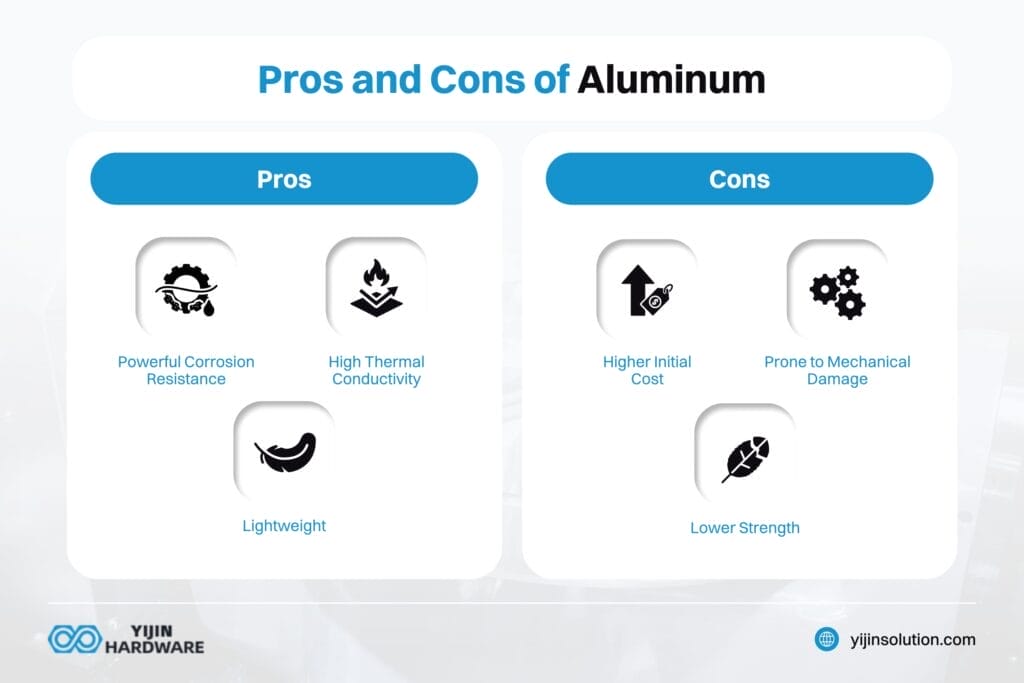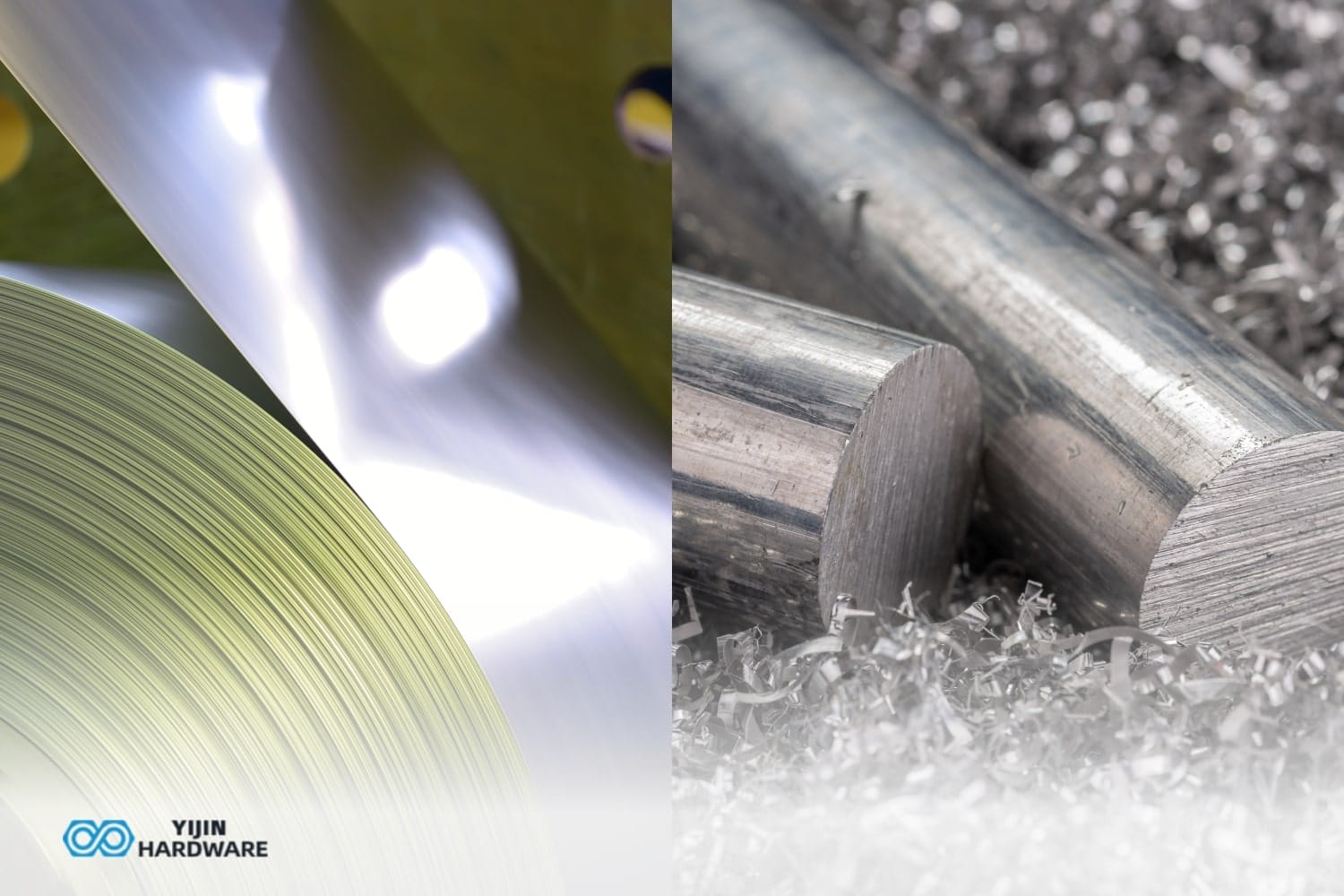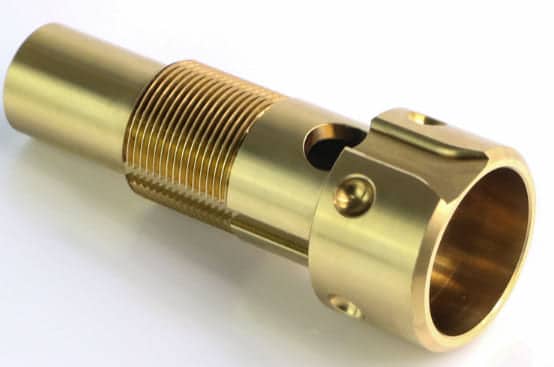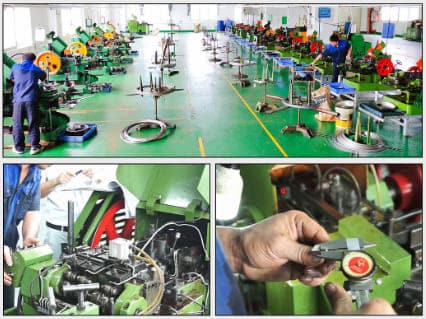When it comes to manufacturing, your choice of materials can affect the performance and longevity of your projects. Aluminum and galvanized steel are two material options suitable for a variety of applications that require specific metals.
As a CNC manufacturing service company, Yijin Hardware understands that knowing the differences between these materials is important to get the best out of your project. Let’s examine galvanized steel vs. aluminum, their applications, pros and cons, and more!
Key Takeaways
- Galvanized steel has great strength and durability because of its zinc coating.
- Aluminum is lightweight with powerful corrosion resistance and high thermal conductivity.
- Galvanized steel has lower upfront costs, but aluminum has lower maintenance requirements, leading to long-term savings.
- Aluminum performs better in highly corrosive environments, while galvanized steel’s zinc coating can wear over time.
What is Galvanized Steel?
Galvanized steel is steel with carbon that has been coated with a layer of zinc. When this steel is dipped into zinc, it improves its corrosion resistance. The galvanization process usually involves dipping the steel in molten zinc, which creates a powerful shield against environmental hazards, rust, and corrosion.
This zinc coating doesn’t just protect the steel, it also acts as a sacrificial anode. This means that the zinc will corrode before the steel does, extending the lifespan of the material. As a result, galvanized steel is a popular choice for applications that require a lot of strength and durability.
Properties of Galvanized Steel
| Property | Description |
|---|---|
| Corrosion Resistance | Zinc coating gives great protection against rust and corrosion. |
| Durability | Galvanized steel has a long lifespan, with the zinc coating providing extra protection for up to 100 years in good environments. |
| Abrasion Resistance | Zinc coating enhances abrasion resistance in comparison to organic paint coatings. |
| Formability | Galvanized steel keeps its formability (or flexibility); it can be shaped, bent, and fabricated without jeopardizing its protective properties. |
| Strength | Galvanized steel keeps the core strength of steel. |
| Melting Point | The melting point of galvanized steel is approximately 1,425°F, caused by the carbon content and the zinc coating. |
Common Applications for Galvanized Steel
Galvanized steel is widely used across various industries because of its protective properties and strength. Here are a few common applications:
- Construction: Galvanized steel is a popular choice for building structural components, roofing, and fencing. This is because it has the strength and durability needed for load-bearing applications.
- Automotive Industry: You can often find galvanized steel in vehicle parts and chassis. This is due to its ability to prevent rust, which makes automotive components last longer.
- Manufacturing: Galvanized steel is used in appliances, HVAC systems, and furniture, as the steel’s coating offers resistance to wear and tear and has a longer lifespan.
- Outdoor Structures: Galvanized steel is great for fences, railings, and pergolas. It can handle extreme elements because it’s resistant to corrosion.
Galvanized Steel: Pros and Cons

There are both advantages and disadvantages when it comes to using galvanized steel for your project. Here are the pros and cons:
Pros
- Affordable: A big difference between aluminum and galvanized steel is that galvanized steel is more affordable. This makes it a great choice if your project is budget-conscious.
- High Strength: Galvanized steel offers great tensile strength, making it a good option for load-bearing applications.
- Durability: The zinc coating delivers extra wear resistance, especially in outdoor environments or if it’s used in construction.
Cons
- Weight: Galvanized steel is quite heavy, which can increase transportation and handling costs.
- Corrosion Over Time: Even though the zinc coating protects against rust, it can wear down, especially in highly corrosive environments and if there is no maintenance.
- Limited Malleability: Galvanized steel is less ductile than aluminum, making it difficult to shape into complicated designs.
What is Aluminum?
Aluminum is a lightweight, non-ferrous metal. Moreover, aluminum sheets have a high strength-to-weight ratio, and aluminum has a low density.
Aluminum naturally forms a thin oxide surface coating when it is exposed to air. This aluminum oxide ensures aluminum is more corrosion-resistant without needing extra coatings. As a result, aluminum easily prevents rust and corrosion.
Aluminum also has a high thermal conductivity when it comes to heat and electricity, so it’s a great choice for a variety of applications.
Properties of Aluminum
| Property | Description |
|---|---|
| Lightweight | Aluminum is incredibly light, with a density of around 2.7 g/cm³, which is about ⅓ of steel. |
| Corrosion Resistance | The natural oxide layer protects aluminum against corrosion, self-repairs, and prevents further oxidation. |
| Thermal Conductivity | Aluminum has high thermal conductivity, at about 237 W/m·K. |
| Malleability | Highly malleable, so it can be used for intricate shapes and designs without cracking. |
| Electrical Conductivity | At about 60% as conductive as copper, aluminum is a good, cost-effective conductor of electricity. |
| Melting Point | The melting point of aluminum is around 1220°F, which might make it easier to work with in certain manufacturing processes. |
Common Applications for Aluminum
Aluminum’s properties make it work well for a wide range of applications, such as:
- Aerospace: Many aerospace companies use aluminum for aircraft and spacecraft. This is because it’s so lightweight and improves fuel efficiency and performance.
- Transportation: Aluminum offers better fuel efficiency in vehicles, trains, and bicycles. It also brings down the overall weight, because aluminum is a light metal.
- Construction: Aluminum is also used in construction, specifically in window frames, curtain walls, and roofing materials. Aluminum surfaces are popular because they’re flexible and aesthetically pleasing.
- Electrical Equipment: because aluminum is a great conductor, it is ideal for wiring and electrical components.
Aluminum: Pros and Cons

Let’s get into the pros and cons of aluminum:
Pros
- Lightweight: Aluminum has a lighter weight than galvanized steel, making it a good choice in applications where weight is a concern.
- Powerful Corrosion Resistance: The natural oxide layer protects aluminum from corrosion or rust, which makes it a good choice for harsh environments.
- High Thermal Conductivity: Aluminum can dissipate heat efficiently, so it’s a great option for applications like radiators and heat exchangers.
Cons
- Higher Initial Cost: Many aluminum materials are more expensive than galvanized steel.
- Lower Strength: While aluminum is strong, it is not as durable as galvanized steel for heavy-duty applications.
- Prone to Mechanical Damage: Aluminum can be more prone to dents and scratches, which can interfere with its look and feel, as well as its structural integrity.
Aluminum vs. Galvanized Steel
It’s time to weigh up galvanized steel versus aluminum! There are a few things to keep in mind when you’re deciding between galvanized steel and aluminum, such as strength and costs. We’ve outlined the key differences in the table below:
| Property | Aluminum | Galvanized Steel |
|---|---|---|
| Strength | High strength-to-weight ratio | Stronger, better for structural use |
| Corrosion Resistance | Superior, natural oxide layer | Zinc coating wears over time |
| Conductivity | 4x more conductive than steel | Less conductive |
| Weight | Much lighter | Heavier, but sturdier |
| Costs | Higher upfront costs, lower maintenance expenses | Lower upfront costs, more maintenance |
Here are the main differences in detail:
Strength and Durability
If you’re trying to choose aluminum or galvanized steel, it’s important to consider the strength within the metal. Galvanized steel is the winner when it comes to tensile strength, so it’s the best choice for structural applications. On the other hand, aluminum has a higher strength-to-weight ratio, which is useful for transportation and aerospace.
Corrosion Resistance
Aluminum’s natural oxide layer provides better protection against rust compared to galvanized steel, especially in corrosive conditions. For galvanized steel, the carbon steel is dipped in zinc, which can wear over time.
Conductivity
Aluminum is over four times more conductive for transferring heat properly than steel. This makes aluminum the better choice for applications requiring a high thermal conductivity. Aluminum is also a poor conductor of electricity when compared to copper; however, it is a better conductor of electricity than steel.
Weight
Between the two metals, aluminum is a lot lighter. This makes it the better choice for applications where reducing weight is critical, such as in aerospace, automotive, and transportation industries, helping improve fuel efficiency and overall performance. However, some applications might require a metal that is sturdier and stronger than aluminum, like galvanized steel.
Costs
Galvanized steel is a lot less expensive upfront. However, aluminum has lower maintenance requirements, which could lead to cost savings in the long run.
Yijin Hardware: Expert On-Demand CNC Manufacturing
To choose between aluminum and galvanized steel essentially depends on the specific requirements of your project. You need to take into consideration your project’s needs in terms of strength, weight, corrosion resistance, conductivity, and budget.
At Yijin Hardware, we are experienced in providing expert on-demand CNC manufacturing services to bring your vision to life. Reach out to our friendly team for a quote!
Galvanized Steel vs. Aluminum FAQs
Does galvanized steel last longer than aluminum?
Yes, galvanized steel usually lasts longer than aluminum because of its corrosion-resistant zinc coating. However, aluminum can be more durable in specific conditions, as in highly corrosive environments such as coastal or industrial areas.
Which is stronger: alloy steel vs. galvanized steel?
Alloy steel is generally stronger than galvanized steel. This is because alloy steel has extra elements, like chromium or nickel, which improve its mechanical properties and hardness.
What can damage galvanized steel?
Air exposure and acidic or alkaline substances can damage galvanized steel. In terms of air exposure, chemicals like sulfur dioxide, carbon dioxide, and airborne chlorides can cause major damage. Any substance with a PH range outside of 6 to 12 can corrode galvanized steel.
Back to Top: Galvanized Steel vs. Aluminum

 info@yijinsolution.com
info@yijinsolution.com (+86) 188-2253-7569
(+86) 188-2253-7569







